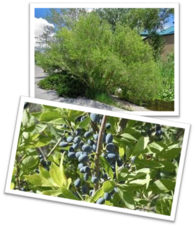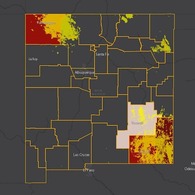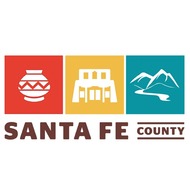
|
August 2024 Newsletter
|
Chasing Credits – The Interplay of State and Federal EV Incentives

Before beginning our discussion, it is important to note that this article should not be taken as tax advice. Instead it is intended to provide a high level overview of State and Federal EV tax credit programs and the scale of rebates potentially available. For your own tax related questions please consult a qualified tax professional.
If you are interested in purchasing an electric vehicle (EV) or plug-in hybrid electric vehicle, (PHEV) State and Federal tax credit programs can significantly reduce the sticker price of a new or used car. A buyer of a new EV could potentially save $10,500 if they take advantage of both programs and a buyer of a used EV could save $6,500.
In an ideal world, participating in these programs would be as simple as picking your car, signing the paperwork and driving off into the sunset with extra cash in your pocket. Unfortunately, the size and availability of rebates is dependent upon a number of factors including the price, make, model and year of the vehicle and when and where the vehicle is purchased.
New Mexico Clean Car Tax Credit
Adopted this year, the New Mexico Clean Car Tax Credit is the least restrictive of the two programs. Qualifying vehicles must be:
- Purchased or leased from a dealer licensed in New Mexico or within tribal lands in New Mexico.
- Registered and titled in New Mexico.
- Have a base Manufacturer Suggested Retail Price (MSRP) of $55,000 or less for new vehicles.
- Have a market value of $25,000 or less for used vehicles.
- Used vehicles must be at least 2 years old.
In short, as long as you shop at a licensed dealership and register your vehicle in New Mexico, there will be many EV and PHEV options available that qualify for the credit. The value of credits varies depending on the vehicle type (EV/PHEV), the year it was purchased and if the vehicle is new or used. Before 2027, new EVs will receive a $3,000 credit and new PHEVs will receive a $2,500 credit; used EVs will receive a $2,500 credit and used PHEVs will receive a $2,000 credit.
Federal EV Tax Credit
The Federal tax credit program is more restrictive. In order to encourage domestic sourcing and manufacturing, credit eligibility is dependent upon where EVs are made and where their battery components and materials are sourced. The origin requirements will become more stringent over time and manufacturers may change their processes in the future to comply with the program. As a result, the vehicles which qualify in one year may be different than those which qualify in the next and some vehicles may only receive a partial credit. Fueleconomy.gov is an excellent resource to determine which vehicles in each year are eligible.
New EV purchases can earn up to $7,500 in Federal tax credits. To qualify applicants must earn less than $150,000 to $300,000 annually (depending on filing status), new vehicles must cost less than $80,000 for vans, SUVs and pickups and $55,000 for all other vehicles. Used vehicles can earn up to $4,000 in Federal tax credits and have different income requirements (applicants must earn less than $75,000 to $150,000 depending on filing status) and must have a sale price less than $25,000.
Potential Scenarios
In many instances a vehicle may qualify for the State tax credit program but not for the Federal tax credit program. If a vehicle is purchased out of state it could qualify for a Federal incentive but miss out on the State counterpart.
To illuminate how the State and Federal programs interact, the table below provides the potential value of State and Federal tax credits from the perspective of someone buying a EV or PHEV in 2024.
|
Scenario
|
Potential Federal Tax Credit Value
|
Potential State Tax Credit Value
|
Potential Total Tax Credit Value
|
|
Scenario 1: A 2022 Used Chevrolet Bolt EUV purchased at a NM Licensed Dealership
|
$4,000
|
$2,500
|
$6,500
|
|
Scenario 2: A new 2024 Jeep Wrangler PHEV purchased at a NM Licensed Dealership
|
$3,750
|
$2,500
|
$6,250
|
|
Scenario 3: A new 2024 Tesla Model 3 Performance purchased at a dealership within Tribal lands
|
$7,500
|
$3,000
|
$10,500
|
|
Scenario 4: A new 2024 Hyundai Ioniq 5 purchased at a NM Licensed Dealership.
|
Not Eligible
|
$3,000
|
$3,000
|
The interplay of State and Federal incentives may not be straightforward however these programs can significantly reduce the upfront costs of EV or PHEV adoption. In many cases an EV could end up costing the same as, or even less than a comparable internal combustion engine (ICE) vehicle. When considering the total cost of ownership, which includes not only the purchase price but also factors like fuel and maintenance costs, EVs become an even more attractive option.
When considering the purchase of a new EV or PHEV vehicle, take time to consider the tax credit programs you qualify for. It may make the buying decision that much easier.
|
Native Plant of the Month: New Mexico Privet (Forestiera pubescens)

One of our favorite Southwest native perennial plant species is the New Mexico Privet. This deciduous shrub or small tree, is also known as stretchberry, desert olive, tanglewood, devil's elbow, New Mexico olive, and spring goldenglow. The bark is a beautiful shade of white, and the leaves usually turn yellow in the fall.
Tiny, fragrant yellow flowers appear in clusters late March to early April, even before the leaves emerge. The flowers are an important nectar source for native bees. Many species of birds eat the blue-black berries, which look similar to a young olive, and ripen from June to September. As this plant is dioecious with separate male and female varieties, if you want to grow one that produces fruit, be sure to buy an identified female.
Forestriera pubescens can be trimmed to be tree-like, or left as a rounded bush. Mature individuals can grow 12-18 feet tall. This multi-faceted beauty is a great addition to yards and parks in our arid climate; it is drought tolerant, adaptive to a variety of growing conditions, offers food and habitat for wildlife, and can provide a natural boundary line when used as a hedge. Natural resource managers use it for mine land reclamation.
Young and newly planted privets require some watering and weed management to get started, therefore it is not an ideal candidate for undeveloped areas, where watering isn't possible during establishment. If you have a large space to fill in your yard, want a natural “fence”, or have space on the edge of a community garden, this species is a great choice!
|
What Can I do?
“Public Health, Climate Change and Systems” by Jonathan Lameman

In my experience as an intern for Santa Fe County, and in my activism with NGOs in the past, it is my observation that Governments operate through many departments, each with their own specialty, which, if I think about the profession that I want to pursue in my schooling with UNM this fall, is similar to the medical field. Both have specializations in many fields which all cooperate together to achieve goals. Every department of specialty has their own duty in their specialized field of work. Radiology, the medical field I am interested in pursuing, cooperates with surgeons, has routine checkups with patients, and analyzes x-ray results. All of these tasks and more come with the help of different medical fields. Meanwhile, government organizations need to collaboratively work with departments such as public works, public safety, land development, sustainability, community services and other departments which have their own duties contributing to the field of work in service to the community.
My experience with Earthcare gave me an introduction to the environmental impacts of government decision making with the oil rig protest as we were advocating for the shut-down of an oil rig within reservation land which was causing health problems in the community. PSE Energy states that, “Nitrogen Oxide-a pollutant associated with burning natural gas-is responsible for over 80% of asthma attacks” (Michanowicz et al., 2023). In my experience, the legislature listens to the outcries of public demands and wants to satisfy the needs of constituents if the ask is reasonable.
Youth United for Climate Crisis Action (YUCCA) in the past, sent volunteers to sit in our state capitol to protest harmful environmental practices knowing they would be forcibly removed and arrested in order to raise awareness and show how large of an issue climate change really is. This was my first actual activist experience, and I learned valuable lessons in leadership and the need for taking initiative in caring for my community and the environment. These valuable lessons apply in the medical field as healthcare professionals take the leadership role to solve patient cases with other specialists in the medical field.
I worry for the future of the earth’s health and sustainability even when the topic of climate change is a difficult challenge. In the next decade, it’s concerning how much rising temperatures are affecting communities. Global level temperatures are increasing no matter what changes we make towards sustainability currently. There are things that we can do as a community as we face these challenges. Earthcare’s work strives to increase resilience and health in communities. The experience of working with this NGO gave me an appreciation towards wanting to help in the environmental area and to work towards a more sustainable lifestyle. Energy efficiency towards a more sustainable lifestyle can, “slash US energy use and greenhouse gas emissions by 50% by 2050” (Ungar et al., 2019). Earthcare focuses on day-to-day needs; supply drives such as clothes, school supplies, and toy drives; reusing supplies for families in need. These supplies also encourage a more sustainable lifestyle in exchange, allowing families to free up income for other important bills such as rent. Throughout our systems I see the similarities in goals and service: NGOs, and governments provide for a community, which mirrors the systems in the medical field which also strives to increase health and help patients.
The world is slowly depleting in resources, so we have to come together and work together in all of our systems to make a real change. No matter a person’s profession, the ties that connect us involve the government and its specialized departments, all contributing together to get something done--and the same system of specialties in service is prevalent with healthcare and many other non – profit organizations. There are multiple people with different skill sets all contributing to a singular cause. If the focus is on increasing community health and resiliency, we all benefit. Government, healthcare, and non-profits all seek to solve an issue whether protesting for a cause, giving patients the help they need, or creating order and emergency services for the public and more. I have enjoyed my time working for the County as I get to work alongside the inner workings of government and being able to experience the systems of government on a local level. I am honored to be able to learn ways to connect and give strength to my own community with these opportunities given to me.
Bibliography
Earthworks, FracTracker Alliance. The Oil and Gas Threat Map. Washington D.C., 1612 K St., NW, Suite 904, 2024.
Michanowicz, Drew. Air Pollution and Health Impacts of Oil and Gas Production. Oakland, California: 1440 Broadway, Suite 750, 2023.
Ungar, Lowell. Nadel, Steven. Halfway There: Energy Efficiency Can Cut Energy Use and Greenhouse Gas Emissions in Half by 2050. Washington D.C., 529 14th Street, NW, Ste. 600, 2019.
Image 1, Oil and Gas Threat Map: https://oilandgasthreatmap.com/threat-map/new-mexico/
|
Other Highlights
(click the banners below for more information)

|
Our August Picks
(Click on the blue titles for more information)
|

Friday - Saturday
August 2nd - 3rd
8:00am-5:00pm
The Stanley, Jacona, & Eldorado Transfer Stations will be suspending deduction on active solid waste permits for Santa Fe County Residents. Learn more on our Reduce, Reuse, Recycle page.

Tuesday, August 6th
10:00AM - Noon
This class will look closely at leaves as well as flowers in the Aster family. Improve your identification skills by looking closely at their leaves; looking at the arrangement, shape, edges, veins, and hairs can all help with identification.
|
|

Monday - Thursday
August 26th - 29th
A professional development opportunity for state and county coordinators, agents, and educators from across the country.

Wednesday, August 21st
6:00 PM - 7:30 PM
Read about and discuss the wonders of the natural world with like-minded people. Each session revolves around a new title from a curated list of recent publications.
|
|

Thursday, August 29th
5:30 PM - 7:30 PM
Co-hosted by Dreams In Action, Sierra Club Rio Grande Chapter and The Semilla Project, these gatherings are space for community members to ask questions and collaborate with state legislators.

Thursday, August 22nd
11:00 AM - Noon
Join us to learn more about the diverse lives of wasps! Pollinator Conservation Specialists, Jennifer Hopwood and Rae Powers will outline the roles of wasps, highlight some key groups, outline conservation measures, and address concerns about wasps.
|
|
|
|
|
|
|
Sharing
Share this issue with others! 
Sustainability Questions?
We are your local advisors on all thing's sustainability in Santa Fe County. Contact us with questions or to suggest topics for future newsletters!
Jacqueline Beam, jybeam@santafecountynm.gov
Will Donahoo, wdonahoo@santafecountynm.gov
Nav Khalsa, nkhalsa@santafecountynm.gov
Michael Carr, mcarr@santafecountynm.gov
Click to visit the Sustainability webpage
|
|